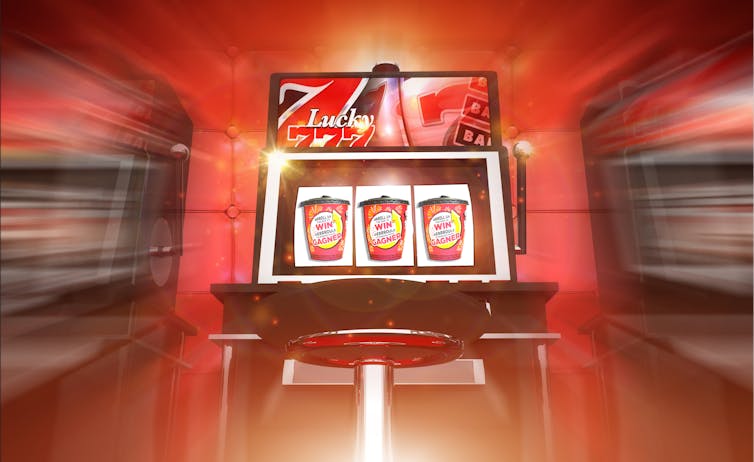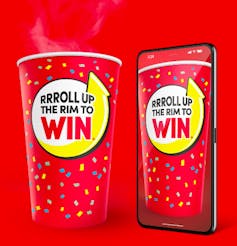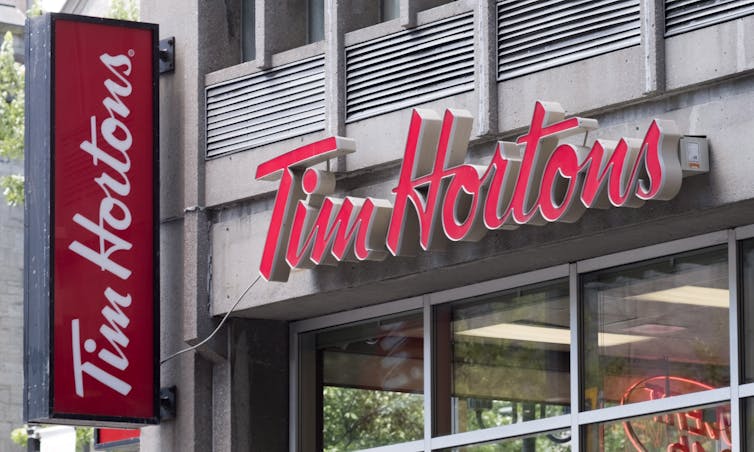 By
adding
a
‘digital
roll’
to
its
iconic
game,
Tim
Hortons’
Roll
up
the
Rim
contest
now
has
some
statistical
similarities
to
slot
machines.
(Photo
Illustration/The
Conversation)
By
adding
a
‘digital
roll’
to
its
iconic
game,
Tim
Hortons’
Roll
up
the
Rim
contest
now
has
some
statistical
similarities
to
slot
machines.
(Photo
Illustration/The
Conversation)
Michael Wallace, University of Waterloo
Roll up the Rim, Tim Hortons’ iconic seasonal sweepstakes, is back … sort of. Just days before the launch of this year’s contest, the coffee chain took the unprecedented decision to eliminate the use of its regular promotional paper cups because of concerns about COVID-19.
As a researcher of health statistics, I agree with the company’s statement that it’s not “the right time” for their staff to collect winning rolled-up rims “that have been in people’s mouths during this current public health environment.”
Changes had already been planned for this year’s game, including a digital element, fewer prizes and a more complex game structure. After removing the physical cups, Tim Hortons has scrambled to reconfigure the contest even further.
All these changes mean players this year face a probability puzzle, one that turns the traditional game into a casino-style slot machine.
So how can you be a high roller (or at least win a free coffee)? As a statistician, I think about these things.
A familiar contest to Canadians
For
over
three
decades,
Roll
up
the
Rim
followed
a
familiar
format:
buy
a
coffee
in
a
promotional
paper
cup,
roll
up
the
cup’s
rim
and
maybe
(just
maybe)
win
a
prize.
 One
of
the
major
changes
in
Tim
Hortons
Roll
up
the
Rim
contest
this
year
is
the
chance
to
have
‘digital
rolls’
using
the
firm’s
app.
(Tim
Hortons)
One
of
the
major
changes
in
Tim
Hortons
Roll
up
the
Rim
contest
this
year
is
the
chance
to
have
‘digital
rolls’
using
the
firm’s
app.
(Tim
Hortons)
With millions of free coffees and doughnuts available each year — along with a comparatively tiny pool of major prizes, including TVs, cars and cash — players became accustomed to the heavily advertised 1-in-6 chance of winning.
These odds were easy to verify: Tim Hortons produced a pre-specified number of promotional cups, of which a pre-specified number were winners. If there were 60 million cups of which 10 million were winners, then picking a cup at random gave you a 1-in-6 shot at a prize.
Before the COVID-19 outbreak, Tim Hortons planned to use physical cups for only the first half of the four-week contest — part of the company’s plan to cut down on waste. The company had previously stated that this year, paper cups would come with lower odds: just one out of every nine would be marked as a winner.
Tim Hortons has hastily replaced this element of the game with an at-the-register instant win component. Customers will, with those same 1-in-9 odds, be told at the point of sale if they’ve won a coffee coupon. But buyer beware: those odds are per-transaction, not per-beverage purchased on the same order. Available during the first two weeks of the contest (March 11-24), Tim Hortons estimates this will lead to some $1 million a day in complimentary hot beverages. That $14 million total approximately equals the value of all minor prizes (beverages and baked goods) originally assigned to the physical cup component of the promotion.
So what about the big ticket items? The TVs, cars and cash? For those, you’ll need to play another new element to the game.
All about the app
This year’s contest was always about one thing: driving consumers to Tims Rewards, the company’s loyalty app. In addition to the at-the-register component, players with the company’s rewards app also earn “digital rolls.” A standard purchase earns one digital roll, while bringing in a reusable cup earns three digital rolls. (The company has suspended the use of reusable cups also over concerns about COVID-19. Customers will get three digital rolls if they bring in a reusable cup, but the drink will be served in a paper cup.)
These digital rolls will appear to work just like the real thing: tap the screen to “reveal” whether you’ve won. But the reality is subtly — but significantly — different.
First, let’s look at the odds. We already know that for the first two weeks of the contest there is a 1-in-9 chance of getting your hot beverage purchase for free. Your odds have therefore gone down from the 1-in-6 of previous years, but digital rolls offer another chance to win.
Exactly what that chance works out to, however, is harder to compute.
More players means worse odds
The
digital
element
of
the
contest
has
8,620,056
instant
win
prizes,
including
all
the
major
prizes
originally
intended
for
the
physical
cups.
Depending
on
how
players
engage
with
the
app,
each
purchase
could
generate
zero,
one
or
even
three
digital
rolls.
The
company
has
stated
the
digital
odds
of
winning
a
beverage
or
food
prize
“will
be
better
than
the
1-in-9
odds
at
restaurants.”
Based
on
those
odds
and
assuming
all
digital
prizes
are
eventually
awarded,
this
suggests
Tim
Hortons
expects
around
77
million
—
or
fewer
—
digital
rolls
to
be
played.
 The
prizes
in
the
Roll
up
the
Rim
contest
range
from
millions
of
free
coffees
and
doughnuts
to
electric
cars.
THE
CANADIAN
PRESS/Paul
Chiasson
The
prizes
in
the
Roll
up
the
Rim
contest
range
from
millions
of
free
coffees
and
doughnuts
to
electric
cars.
THE
CANADIAN
PRESS/Paul
Chiasson
But the company cannot know for certain how many coffees it will sell or how many players will use the app. In statistics we often make guesses, and when we do it’s essential we understand what might happen if our guesses are wrong.
Here, if sales are lower than expected — or fewer people use the app — there will be fewer digital rolls and better odds for those who do play. But we can use this 1-in-9 guess to estimate your chances of winning at the various stages of the contest.
For the first two weeks, every customer has a 1-in-9 chance of winning instantly at the register. Players with the app additionally receive a digital roll. If this also comes with 1-in-9 odds, then your chances of winning at least one prize are boosted to better than 1-in-5. The environmentally conscious get three digital rolls for bringing in their reusable cups. These four chances to win (three digital, one at the register) give odds of 1-in-2.7 of winning at least one prize.
If the company’s estimate for the digital game is accurate, then players with the app can expect to win more frequently than in previous years. But remember: your odds get worse the more other people play the digital game — and this dependency ties into another key difference with this new way to “roll.”
A coffee slot machine
When we think about probability, we usually think about random events like the toss of a coin or the throw of a die. Many random events affected which particular cup you ended up with when playing the contest in previous years: maybe you left the house late, or there was traffic, or the guy in front of you ordered the same thing. Your chance of being given a winning cup was always 1-in-6.
The moment that cup was in your hands, however, your outcome became fixed. The words hidden under the rim — regardless of whether it was the delightful WIN/GAGNEZ UN CAFÉ/COFFEE or the dreaded PLEASE PLAY AGAIN/RÉESSAYEZ S.V.P. — would not change. From your perspective, your chances of winning were still, in a sense, 1 in 6. But in reality your chances of winning were 100 per cent or zero per cent. The action of rolling up the rim did not change that probability, it just revealed which of the two outcomes had occurred. (Schrödinger’s coffee, if you will.)
This year, digital rolls are the opposite. These can be played at any time after purchase, and their outcome is not pre-determined. Instead, under the new rules, each of the 8.6 million digital roll prizes are allocated a “winning timeframe”: a short interval of time at some point during the contest period. If you are the first player to play a digital roll during one of these timeframes, you win the associated prize.
Time of play now a factor
This means that, unlike the physical cups of previous years, the outcome of your digital roll is not determined until the moment you choose to play it. Slot machines follow a similar mechanic: hitting the jackpot doesn’t depend on when you last won or if the machine is “due” to pay out. It’s simply about whether you pull the lever at just the right microsecond.
There’s no way to know when to pull a lever on a slot machine and there’s no way to know when to play a digital roll in the Timmies contest.
But with Roll up the Rim, there is one possible way to shift the odds slightly in your favour. We already know that fewer players gives better chances for those that do participate — and it is tempting to speculate about the impact of COVID-19 on this aspect of the game. To do so, however, would be entirely inappropriate and I don’t want to give the impression that something as serious as the coronavirus outbreak should be considered a factor in something as frivolous as a sweepstakes.
Instead, I will make one entirely separate observation.
To
win,
you
have
to
be
the
very
first
person
to
play
a
digital
roll
during
a
winning
time
frame.
This
means
that
you’re
fractionally
more
likely
to
win
if
fewer
people
are
rolling
at
the
same
time
as
you.
The
contest
rules
don’t
state
whether
these
time
frames
are
distributed
evenly
throughout
the
day,
but
if
they
are
—
and
you
don’t
mind
being
awake
at
4
a.m.
—
then
playing
when
most
of
Canada
is
asleep
may
be
your
best
bet.
After
all,
you’ll
probably
need
the
caffeine.![]()
Michael Wallace, Assistant Professor, Department of Statistics and Actuarial Science, University of Waterloo
This article is republished from The Conversation under a Creative Commons license.